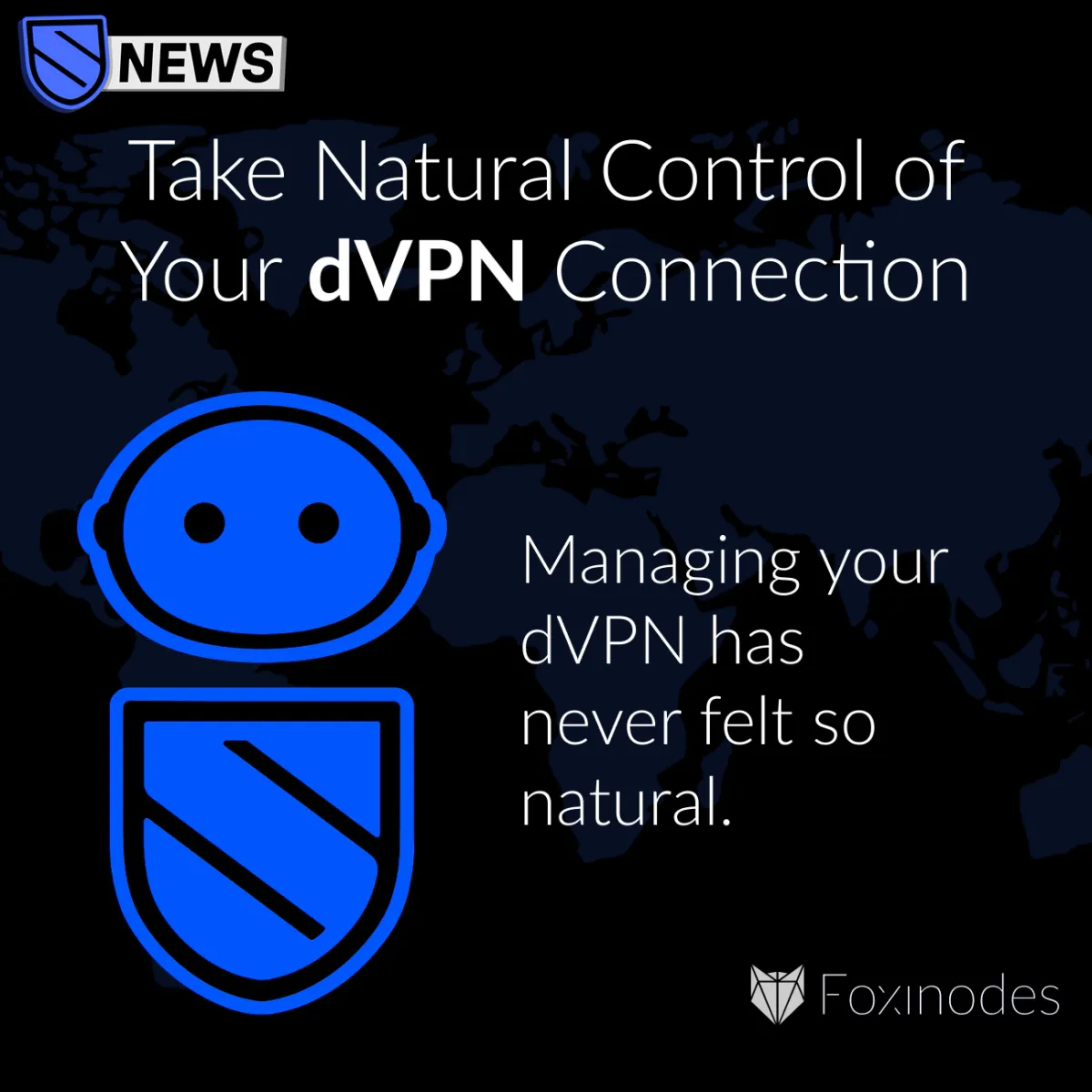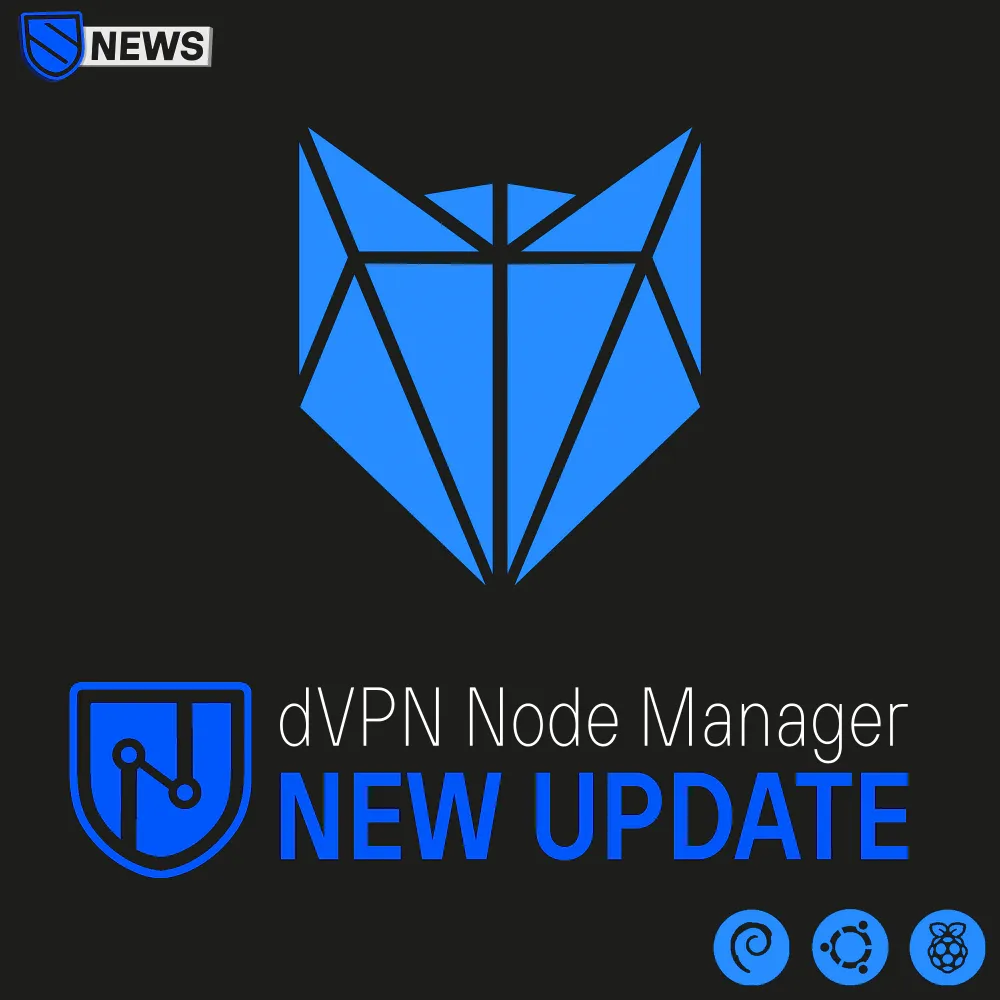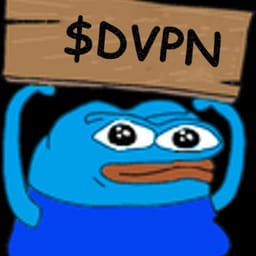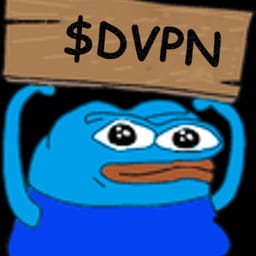Take Natural Control of Your dVPN Connection with AI
"With this model, dVPN users will be able to control their connection simply by speaking or typing natural language commands. The ultimate goal of this project is to provide a ready-to-use AI model that can be seamlessly integrated into existing or future dVPN applications."

• Foxinodes has developed an AI model which allows users to manage dVPN connections through simple typed or spoken requests.
• Precautions have been taken to make the AI model as friendly to user privacy as possible, including local hosting on your device.
• The model has passed its initial training stage, and has now entered open community testing.
• Detailed instructions for operating and testing the model are available.
Continue reading the full article below to find out more.
In a world where privacy and control over personal data are becoming more critical, decentralized VPNs (dVPNs) offer a promising alternative.
But what if managing your dVPN connection could be as simple as typing or even speaking your request? This is the vision behind our AI-powered model—a system designed to let users control their dVPN connections intuitively, using natural language.
Our AI model allows users to control their dVPN with ease, whether by typing simple messages or by speaking directly to their device. Imagine saying, “Start dVPN for Tokyo,” or “what’s my subscription status?” and having the model handle the rest. It’s a step toward a future where controlling your online privacy is straightforward and secure, without the need for complex commands or menus.
This article explores how our AI model works, its potential to safeguard privacy by running locally on user devices, and how you can join us in testing and refining this technology. We’ll cover the roadmap, showcase real examples of how the model interprets commands, and invite you to experience it firsthand. This is only the beginning, and we’re excited to have the community’s help in shaping an AI that respects user privacy while making dVPN management easier than ever.
🎓 What is a dVPN and How Does Sentinel Work?
A decentralized VPN, or dVPN, is a VPN service built on blockchain technology, designed to provide privacy and freedom from traditional, centralized VPN providers. Unlike traditional VPNs, where your data flows through a central server controlled by a single provider, dVPNs operate on a decentralized network of individual nodes. These nodes are people and organizations who share their bandwidth in exchange for compensation, creating a secure and distributed system for VPN access.
The Sentinel blockchain plays a crucial role in this setup. Acting as a mediator, Sentinel connects users who want VPN access with node operators who sell their bandwidth. Through blockchain technology, Sentinel ensures that transactions between users and node providers are secure, transparent, and free from central control. By decentralizing the process, users gain a level of privacy and autonomy that traditional VPNs cannot offer, as there is no central authority that could potentially track or monitor traffic.
In Sentinel’s dVPN ecosystem, every transaction — whether you’re renting bandwidth or providing it — is recorded on the blockchain. This transparency guarantees that providers are compensated fairly while ensuring users are connected only to verified nodes. The result is a VPN service that is inherently more resistant to censorship and centralised surveillance, because it relies on a global, decentralised network rather than a few servers controlled by the same company.
This decentralized approach to VPN services makes dVPNs especially attractive to those who prioritize privacy and wish to avoid reliance on single providers. By leveraging Sentinel blockchain, dVPN users can enjoy a flexible, secure, and private browsing experience, tailored to today’s demand for transparency and data autonomy.

Sentinel Docs is the project's most comprehensive technical knowledge base.
How Can AI Make dVPN Connections Easier?
Our AI model seeks to make dVPN applications more approachable without disrupting or overshadowing the capabilities of existing tools.
The Sentinel blockchain already supports several applications in the dVPN space, each offering users new ways to secure their internet connections with privacy in mind. These applications provide essential features, allowing users to select and connect to nodes, manage subscriptions, and monitor their usage. The developers behind these tools have laid a strong foundation for a privacy-friendly dVPN ecosystem.
Building on that work, our AI model aims to simplify interactions further by introducing natural language commands. The goal is not to replace the existing interfaces but to add a layer of accessibility, making it easier for anyone — from tech-savvy users to beginners — to interact with their dVPN application in a more intuitive way.
Imagine being able to type a command like “connect to v2ray VPN in Rome” or ask your phone, “what’s my VPN status?” and have the AI understand and execute the request instantly. With natural language processing, users can engage with their dVPN as they would with a human assistant, making it accessible to those who may not be familiar with the technical steps required for configuration and management.
Our AI model seeks to make dVPN applications more approachable without disrupting or overshadowing the capabilities of existing tools. Instead, we aim to enhance the user experience by allowing dVPN applications to understand and act on everyday language commands.
In essence, this AI model represents a step toward empowering users to manage their dVPN with ease and confidence, whether they’re typing on a laptop or speaking to their phone. It’s about lowering the barriers to privacy and control, providing a tool that makes dVPN technology accessible to a broader audience, while fully respecting the hard work already achieved by the developers within the Sentinel Ecosystem.
Focused on User Control
When we talk about AI and privacy, there’s often a concern: Isn’t AI supposed to process everything on external servers, potentially exposing sensitive data? That’s a valid point — many popular AI models rely heavily on cloud infrastructure, constantly transmitting data to powerful remote servers for processing. But with our dVPN AI model, we’re taking a different approach.
Our model is designed to be lightweight and efficient in its domain, which means it can run directly on the user’s device, whether that’s a computer or a smartphone. This local execution allows commands and data to be stored on the user’s device, avoiding the need to send sensitive information over the internet.
Unlike large language models (LLMs) that typically require vast amounts of computational power and external servers, our AI model offers a privacy-respecting alternative that aligns with the principles of decentralization. By processing commands on-device, users can interact with their dVPN while retaining control over their data, without relying on cloud-based infrastructure.
In short, this AI model does more than just make managing a dVPN easier — it also respects user privacy, staying fully local and eliminating the need for external data processing.
From Theory to Real-World Application
The ultimate goal of this project is to provide a ready-to-use AI model that can be seamlessly integrated into existing or future dVPN applications.
Our dVPN AI model has reached an exciting stage. After an initial training phase, the model has developed a foundational understanding of natural language commands, enabling it to recognize common phrases and respond accordingly. But as with any AI, the real test comes when it’s applied in real-world conditions.
We are now entering a test phase, during which the model will be exposed to real interactions with users. By collecting messages from users, we will be able to get an idea of how the model understands requests in various real-world scenarios. This data will be invaluable in refining the model’s responses and improving its ability to interpret commands accurately and contextually. With each new interaction, we will identify areas for improvement, make the necessary adjustments and retrain the model to improve its understanding and responsiveness.
With this model, dVPN users will be able to control their connection simply by speaking or typing natural language commands. The ultimate goal of this project is to provide a ready-to-use AI model that can be seamlessly integrated into existing or future dVPN applications. Whether managing subscriptions, selecting nodes or checking connection status, users will have a powerful tool that will make dVPNs more accessible and user-friendly than ever before.
Examples and Analysis
To illustrate how our AI model interprets natural language commands, here are a few examples that show how it breaks down each sentence into actionable insights. By identifying the user’s intent and extracting key entities, the model enables easy and intuitive control over a dVPN connection. Each JSON output below reflects the structure of the model’s response, capturing the action and any relevant details to carry out the request.
Example 1: “Start VPN for Sydney.”
When a user requests to start a VPN connection for a specific location, the model identifies the intent (dvpn-start) and the relevant location (Sydney).

Example 2: “Stop the VPN linked to Brazil right now.”
Here, the user wants to stop a VPN connection associated with a specific location. The model identifies the intent (dvpn-stop) and extracts Brazil as the relevant location.

Example 3: “Can you retrieve my wallet address for the crypto deposit?”
In this request, the user is asking for their wallet address for a cryptocurrency deposit. The model detects the intent (wallet-address) but doesn’t need to extract additional details, as the action is straightforward.

Example 4: “I’d like to check the status of my subscription in Seoul.”
In this case, the user wants to check their subscription status and specifies a location (Seoul). The model identifies the intent (subscription-status) and extracts Seoul as the relevant location.

Example 5: “How fast is my connection to Foxinodes?”
When the user asks about the speed of their connection to a specific node (Foxinodes), the model identifies two actions: connection-speed and dvpn-check. It also extracts the node moniker, Foxinodes, as a key entity.

How to process the user request
Each JSON response shows how the model interprets a user’s command. The sentence field captures the original request, actions indicates the detected intents, and words_in_order and words_by_tags display extracted entities like locations or node names.
This structured output allows any existing dVPN application to understand the user’s request and process it accordingly. By analyzing the actions and words, an application can recognize the user’s intent and use the listed details—like location or node name—to perform the requested action efficiently. In this way, the model acts as a bridge between the user’s natural language commands and the application’s functionalities, making dVPN management both intuitive and precise.
List of Actions
Our AI model has been trained to interpret a wide range of user requests, categorizing each command by action. This ensures that users can interact with their dVPN naturally and still achieve the precise action they intend. Below is a comprehensive list of the actions that the model can recognize, along with example phrases.
These actions ensure that users can make a broad range of requests related to dVPN management, wallet details, and subscription handling, allowing for precise and effective control over their dVPN experience.
dVPN Connection Management
- dvpn-start: Initiates a dVPN connection or starts a specific dVPN node.
Example: “Please start a VPN connection to Paris.” - dvpn-change: Switches the current dVPN connection to a different node or protocol.
Example: “Switch my dVPN to the node in New York using WireGuard.” - dvpn-stop: Stops the active dVPN connection.
Example: “Stop the dVPN connection right now.”
Connection Status and Diagnostics
- dvpn-status: Provides the current status of the dVPN connection.
Example: “What’s the current status of my VPN?” - dvpn-check: Verifies whether the dVPN connection is active.
Example: “Can you check if my dVPN is currently active?” - dvpn-history: Retrieves information on the user’s dVPN connection history.
Example: “Show me my dVPN connection history for the past week.” - connection-issue: Flags a general connection issue, excluding specific cases like slow speed or blocking.
Example: “I’m having trouble connecting to the internet.” - connection-slow: Indicates a slowdown in the connection speed.
Example: “Why is my dVPN connection so slow?” - connection-blocked: Notes that certain websites or online resources are unavailable or blocked.
Example: “I can’t access some websites with my dVPN.”
Wallet and Subscription Information
- wallet-balance: Shows the available balance in the user’s crypto account.
Example: “What’s my current wallet balance?” - wallet-address: Displays the deposit address for adding funds to the crypto account for dVPN subscription.
Example: “What’s my deposit address for the crypto wallet?” - subscription-status: Checks the current status of dVPN subscriptions.
Example: “What’s the status of my current dVPN subscriptions?” - subscription-price: Provides the fee required for subscribing to the dVPN service.
Example: “What’s the fee for subscribing to the service?” - subscription-renew: Requests a subscription renewal to a specified node.
Example: “Renew my subscription to the node in Berlin.” - subscription-cancel: Cancels a subscription to a specified node.
Example: “Cancel my dVPN subscription with the London node.”
Network and Node Search
- network-stats: Provides statistics on the available dVPN nodes.
Example: “How many dVPN nodes are currently available?” - network-search: Searches for dVPN nodes based on specific criteria.
Example: “Find a fast dVPN node in Canada with v2ray.”
Connection Usage and Details
- connection-usage: Retrieves information on the data consumed by the dVPN connection.
Example: “How much data has been consumed so far?” - connection-protocol: Shows the protocol currently being used by the VPN.
Example: “Which VPN protocol is currently active?” - connection-duration: Provides the total session time for the current dVPN connection.
Example: “What is the current session time for the VPN connection?” - connection-ip: Displays the IP address currently being used by the VPN connection.
Example: “What is the IP address being used by the VPN?” - connection-speed: Checks the current download speed of the VPN connection.
Example: “What is the current download speed of the VPN?”
General Assistance
- need-help: Requests assistance for the next step or guidance on available actions.
Example: “What do you want me to do next?”
List of Key Attributes
In addition to detecting the action, our AI model extracts key attributes from user commands. These attributes provide additional context, enabling the model to execute actions with greater specificity. Here’s a detailed list of attributes the model can recognize:
- Location: Represents specific countries or cities (“Tokyo”, “Brazil”) where the user wants to connect.
- Protocol: Indicates the protocol type, with possible values being
v2rayorwireguard. - Speed: Refers to the desired or current connection speed (“400 MB”, “2 GB”).
- Status: A criterion for “dvpn-status” requests, indicating connection details like speed, bandwidth, upload, or download status.
- TimePeriod: Specifies a time range for connection history or usage data (“last month”, “today”...).
- NodeMoniker: The name of a specific dVPN node (like “Foxinodes UK DVPN”).
- NodeAddress: The address of a dVPN node, formatted like “sentnode1r22s0vuau9hyzfdzenrnvq4r8dvtps7m0hant4”.
- Symbol: Represents cryptocurrency symbols such as DVPN, ATOM, OSMO, SCRT, and DEC.
- Chain: Indicates the blockchain chain name, with values like Sentinel, Cosmos, Osmosis, Decentr, and Secret.
By identifying these attributes, the model can accurately process and act on user commands, offering personalized and contextually relevant responses. This structured attribute recognition allows for seamless execution of even complex user requests in a way that feels intuitive and responsive.
Test and Improve the Model
We invite you to join us in testing this AI model and shaping its future. You can try it out directly via our Telegram bot using the link below.

As you send commands to the bot, you’ll see how the model interprets each request in real time, revealing detected actions and relevant details in JSON format.
This is a unique opportunity to experiment with different phrases and see how the model understands your requests. Whether it’s ‘Start a VPN for Tokyo’, ‘Check my wallet balance’ or ‘Show me my connection history’, feel free to try out a wide range of commands. Every interaction helps us refine the model, allowing us to gather valuable information and adjust the AI to improve accuracy and responsiveness.
Thanks to your input, we can better understand the different ways in which users can express their requests, helping us to ensure that the final version of the model is as versatile and user-friendly as possible. Thank you for helping us make dVPN control simpler and more intuitive for everyone!
Conclusion
This AI model is still in its infancy and, with the help of the community, it can continue to develop and improve. As we refine its understanding of natural language commands, your feedback and interactions are invaluable. By testing the bot, sharing your feedback and experimenting with different commands, you become a key part of this project, helping us to refine a tool that makes dVPN management simpler and more accessible for everyone.
We invite you to take an active part in this journey. Join us on Telegram or Discord and try out the bot to see how your contribution directly helps its development. Whether you’re part of the Sentinel community or just interested in decentralised privacy solutions, spread the word, share the bot and let others discover this innovative way to manage their dVPN.
Read the articles below to learn about Casanode and dvpn-node-manager, two other products created by Foxinodes for Sentinel.


Join Our Journey
At dVPN News, every member of the Sentinel community is a contributor. Whether you're writing articles, sharing tutorials, or participating in discussions, your involvement is what drives our collective growth, and best of all it's rewarded! Together, so if you to contribute to the growth of the Sentinel Network, you are in the right place!
Connect with Us
Stay in touch and be part of our growing community:
- Follow Sentinel on X.
- Follow the Growth DAO on X.
- Join the Growth DAO community Telegram Group.
- Join the official Sentinel Subreddit, r/dVPN.








